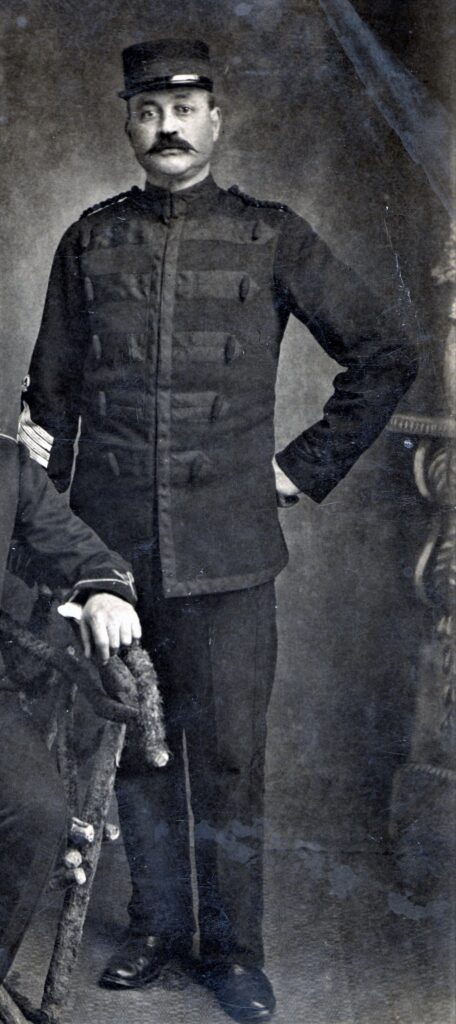
Above is a photograph of the last Sgt Major in his uniform. His uniform was different to any other Sgt as it has the 4 reverse stripes on his right arm and above it the crown.
As far as I am aware, the Dorset Constabulary were the only Police Force to have this rank, which took over from its original name the Drill Sergeant.
The rank was first introduced in the Dorset Constabulary in 1869 by the then Chief Constable. Capt Amyatt BROWN, who was an Army officer in the Crimean War. BROWN later changed his name to Capt Amyatt E AMYATT by dead poll, after having taking up his appointment in Dorset.

The bodyguard for her Majesty Queen Victoria’s judge of Assize was a posse of Javelin men ( above photograph) regarded as a kind of militia and the Chief Constable recommended to the Police Committee that the duties of guarding H.M. judges should be with policemen as the Chief Constable wanted to promote his men.
The Police Committee accepted the Chief Constables recommendation and that a set standard of charges be made for the Constables carrying out these duties, hence the formation of the Police Assize squad under the command of a Sergeant Major.
There were 24 specially selected policemen of smart military bearing and of a uniform height of over 6 feet headed by two trumpeters. The posse were rigidly drilled in a particular form of ceremonial ritual in order to effectively protect the judge from any violence or harm and thus maintain the Kings or Queens peace. The posse were necessary after the savage sentences meted out by Judge JEFFREYS at his bloody Assizes at Dorchester in earlier years where he sentenced many people to be beheaded and their heads impaled on the railings of the Parish church for the public to see.
The Court of Assize dealt with the most serious cases against the realm, treason, murder etc and the judges were responsible for certain court circuits. The county town of Dorset was Dorchester and Poole had its own Assizes until 1888 because Queen ELIZABETH 1st granted it a charter of the county of the town of Poole which it maintained as its title until 1974 and to this day retains its Sheriff but in name only without any judicial power.
Before any opening of the Assizes, her majesty’s judge always attended divine worship at the Parish church where a short special service was conducted by the rector, the judges chaplain and the High Sheriff of Dorset (representing the realm) and also in attendance the Under Sheriff who was legally responsible for the presentation of the calendar of cases for hearing and the police bodyguard.
After the service the judge was escorted on foot from the church to the Court of Assize. This was in the form of a unique and picturesque ceremonial parade through the street which were clear of traffic, headed by the police trumpeters sounding various calls and voluntaries especially appropriate for the ceremony.
The procession moved at a slow walking pace until it reached the court and then the judge passed through the ranks of policemen and then took his seat in the court where a special trumpet call was sounded to remind everyone that the court is in session. This was repeated every day that the judge sat and there was a sounding of a clarion call as the day’s judgement commenced.
A relic of the past and a reminder of the javelin men was that the police attending the court as stewards, carried a long stave with a metal arrowhead which was used in marshalling spectators or bringing them to order, a means of maintaining quiet and respect in regard to the court proceedings. At the closing of the Assizes and the crimes and offences having been expended the Police Posse returned to Police Headquarters under the control of the Sgt Major.
The earliest record of the Drill Sergeant being: a representation is made to the Committee that a Drill Sgt is required because more discipline is required and that a class 1 pc should be promoted to Sgt to take up this position. Later in 1858 the Chief Constable mentions that a “quarter” at Dorchester should be built to house the Drill Sgt within the new HQ.
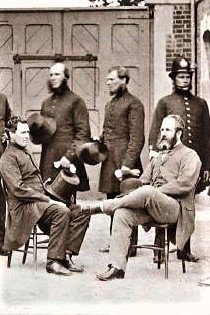
The first photograph of a Drill Sergeant in the Dorset Constabulary so far, is in the 1865 “ conference point ” photograph at the entrance to the Dorchester Headquarters courtyard ,where he can be seen wearing a helmet in company with all the senior officers, although for some time I was unable to name him.
The first Drill Sgt after deduction was Samuel Alfred VICKERY, who had joined as PC 19 when the County Force was established and was based at Dorchester. On the 14th Feb 1857 he was promoted to 2nd class Sgt and I believe this was to help the Chief Constable have more discipline over his men and the first Drill Sgt was born. Twelve years later on the 6th January 1869 the Chief officer of Weymouth Borough Force Charles LIDBURY died and Vickery along with others applied for his job. VICKERY resigned from the County Constabulary on the 8th Apr 1869 and became the new chief who commanded two sgts and nine constables.
Then the next record of a Drill Sgt is in the 1871 when on 12th Jan Charles T AIRES is shown as passing a promotion exam and described as a Sgt Major, so presumably he is now qualified to be a Supt when a vacancy occurs.
In the April 1871 census Charles T AIRES is shown as a police sergeant living at Dorchester police HQ. In 1873 when pay increases are discussed it mentions the rank of Sgt Major but does not mention the holder. Charles AIRES was well travelled and was based mainly in army barracks in London. He came from an army background where in 1860 he was involved in the Chinese wars with the 31st East Surrey Regiment of Foot as a Colour Sgt, regimental number 2968, and he was later discharged as a Sgt Major before taking up the Dorset Constabulary post at the age of 41 years. Charles was the Drill Sgt at Dorchester for four years until about July 1874.
After leaving the Dorset Constabulary he went back to his military background and returned to London where he eventually got a job as a Yeoman of His Majesty’s Royal Bodyguard. Below is a photograph of him at that time.
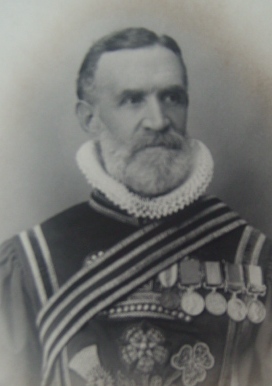
The next records of a Sgt Major in the Force are in the 1875, in the Post Office Directory where the rank is held by George Dukes SEARLE who is shown as a “drill instructor of County Police” , County police station. In Feb 1875 he also passed a promotion exam although like his predecessor he did not achieve the rank of Supt, which was the next rung on the promotion ladder at the time.
George SEARLE just like Sgt Major AIRES also came from the Army as in the 1861 census he is recorded as being regimental number 1029, Corporal of Horse in the Life Guards, and then Corporal Major at Hyde Park Barracks in the 1871 census. I believe he held the rank in the Dorset Constabulary between summer 1874 and 30th March 1876 when he resigned and it appears at the same time he became the publican at the Great Western Hotel just down the road from Headquarters and after that retired in Dorchester to 1, St Helens Road.
Walter PURDIE, a Scotsman was the next to be employed on 27th April 1876 and I believe he held the rank for 14 years until 1890. PURDIE also came from the Life Guards, being shown as a Cpl of Horse in the 1861 census, regimental number 1038.
He is definitely mentioned at Dorchester HQ in 1881census and at the Dorchester Assizes in 1883.
The Constabulary General Orders show that on 3rd Jan 1890, Cpl Major Benjamin CARRUTHERS another Scotsman, of the Royal Horse Guards is appointed as Sgt Major and Drill Instructor and Sgt Major PURDIE is invalidated after tending his resignation and being struck of strength of the Force on 30th November 1889. CARRUTHERS seems to have retired from the Army as he was recorded as a Chelsea Pensioner in April 1890, which does not make much sense as he was already in Dorchester by then.
Between 1890 and 1900 Sgt Major CARRUTHERS is mentioned numerous times when being in charge of the Police Posse at the Assizes and Divisional inspections of the County police stations where the men were drilled. Sgt Major CARRUTHERS retired after 9 years and 341 days and in General Orders it says he resigned on 25 Nov 1899. He probably left to be the publican of the Dorchester Arms in North Square at that time. He is shown in the below photograph with the flat cap.

This photograph above is part of a larger group photograph, which after research I have narrowed down to 1898.
This must be Sgt Major CARRUTHERS in that case, as if you look closely at his uniform he has the 4 reverse stripes on his forearms.
Full photograph below which will be subject to a later post.
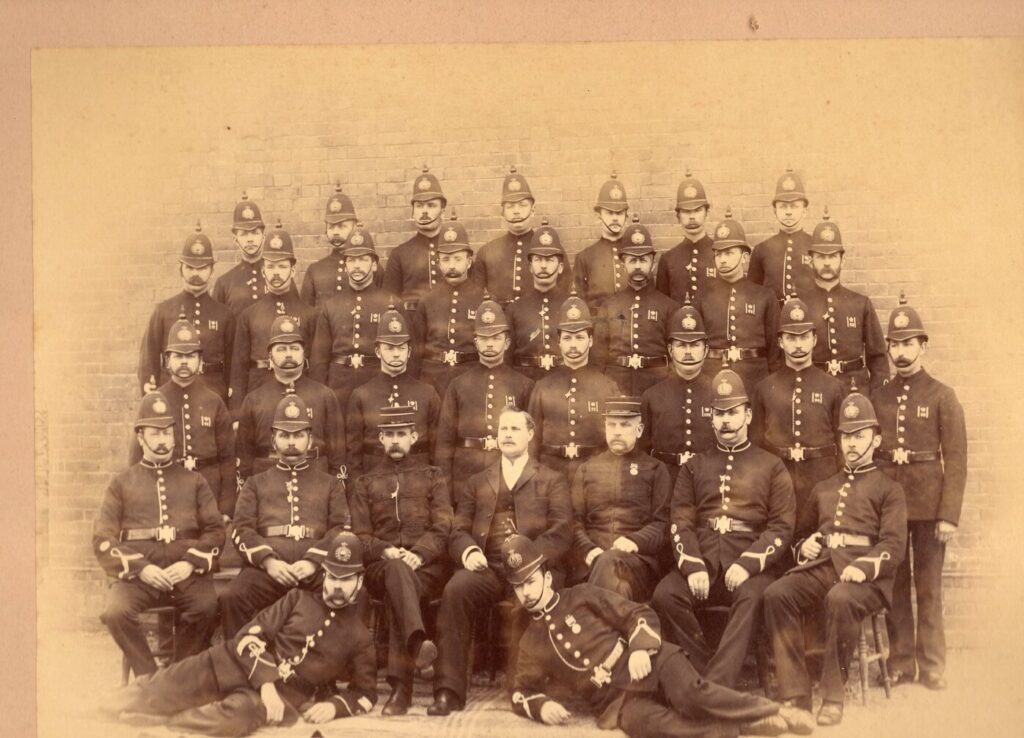
On 25th Nov 1899, William Thomas BOWLES, was then promoted from Sgt to Sgt Major and was the first person for 40 years to be promoted to the rank from within the Constabulary rather than being taken on from the Army. Bowles also had a career in the Army and was given the India Medal for conflict in the black mountains of Hazara between the 1st and 13th Oct 1888. He was a Corporal in the Royal Artillery and his regimental number was 35486. Sgt Major BOWLES held the rank until 1905 when he was promoted to Supt.
Below maybe a photograph of BOWLES from the cover of the 150 year book, when he was Sgt Major, this is just based on the fact he has 4 stripes, so it is a long shot !

The last man to hold the title, before the rank was dispensed with, was Arthur John SWATRIDGE, who like BOWLES was also an ex army man and promoted from within the Force. He was later promoted to Supt in Oct 1910 when the title of Sgt major reverted back to a Sgt.
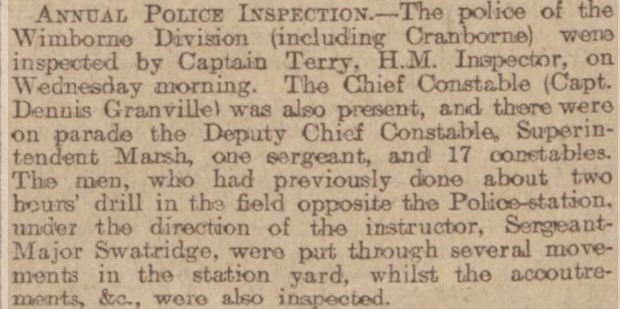
Wimborne annual inspection March 1906.
Sgt Major SWATRIDGE is shown in the below photograph on the right in his Sgt Major uniform wearing his pillar box cap and his jacket showing four stripes and a crown on his right arm. The photograph was taken in 1909 at Dorchester. Next to him is his brother who is in his Army uniform.

Sgt Major SWATRIDGE had a military career before joining the Dorset Constabulary in 1892. He served with the Royal Artillery for nearly eight years where he did tours abroad in India, with an Elephant Battery, going to the relief of Lord Roberts at Kabul, Afghanistan and afterwards at Eden in the then Persian Gulf.
On 13th October 1910, Sgt Major SWATRIDGE was promoted to Supt to take over the vacant position at Sherborne, after Supt Henry CARTER retired. The rank or title of SGT MAJOR was also retired and now called DRILL SGT.
William WHITE was promoted from PC, he also had a military background, a position in the Dorset Constabulary he held for 9 years, even though he was called up for duty in WW1.
Below photograph showing William WHITE ( Drill Sgt) and Supt Arthur SWATRIDGE in 1912. WHITE still has the crown which would appear to show he is the Drill Sgt.
